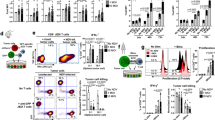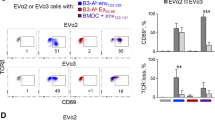Abstract
One chief barrier to cancer immunotherapy is tumor-specific T cell tolerance. Here we compared the ability of hemagglutinin (HA)-encoding recombinant viruses versus 'HA-loaded' dendritic cells to reverse HA-specific CD8 tolerance and to protect mice from tumor challenge. Both vaccines were comparable in activating naive HA-specific CD8+ T cells. However, in circumstances of established tolerance, viral vaccines could break CD8 tolerance in the presence of CD4+CD25+ regulatory T cells, whereas dendritic cell–based vaccines achieved this only after removal of regulatory T cells or the coadministration of a Toll-like receptor (TLR) ligand or irrelevant virus. These results demonstrate that virus provides TLR signals required for bypassing regulatory T cell–mediated tolerance and emphasize the importance of persistent TLR signals for immunotherapy in the setting of established tolerance.
This is a preview of subscription content, access via your institution
Access options
Subscribe to this journal
Receive 12 print issues and online access
$209.00 per year
only $17.42 per issue
Buy this article
- Purchase on Springer Link
- Instant access to full article PDF
Prices may be subject to local taxes which are calculated during checkout







Similar content being viewed by others
References
Hui, K., Grosveld, F. & Festenstein, H. Rejection of transplantable AKR leukaemia cells following MHC DNA-mediated cell transformation. Nature 311, 750–752 (1984).
Restifo, N.P. et al. Identification of human cancers deficient in antigen processing. J. Exp. Med. 177, 265–272 (1993).
Torre-Amione, G. et al. A highly immunogenic tumor transfected with a murine transforming growth factor type β1 cDNA escapes immune surveillance. Proc. Natl. Acad. Sci. USA 87, 1486–1490 (1990).
Ye, X., McCarrick, J., Jewett, L. & Knowles, B.B. Timely immunization subverts the development of peripheral nonresponsiveness and suppresses tumor development in simian virus 40 tumor antigen-transgenic mice. Proc. Natl. Acad. Sci. USA 91, 3916–3920 (1994).
Bogen, B. Peripheral T cell tolerance as a tumor escape mechanism: deletion of CD4+ T cells specific for a monoclonal immunoglobulin idiotype secreted by a plasmacytoma. Eur J. Immunol. 26, 2671–2679 (1996).
Staveley-O'Carroll, K. et al. Induction of antigen-specific T cell anergy: An early event in the course of tumor progression. Proc. Natl. Acad. Sci. USA 95, 1178–1183 (1998).
Lee, P.P. et al. Characterization of circulating T cells specific for tumor-associated antigens in melanoma patients. Nat. Med. 5, 677–685 (1999).
Pardoll, D.M. Cancer vaccines. Nat. Med. 4, 525–531 (1998).
Dranoff, G. & Mulligan, R.C. Gene transfer as cancer therapy. Adv. Immunol. 58, 417–454 (1995).
Schuler, G. & Steinman, R.M. Dendritic cells as adjuvants for immune-mediated resistance to tumors. J. Exp. Med. 186, 1183–1187 (1997).
Pardoll, D.M. Spinning molecular immunology into successful immunotherapy. Nat. Rev. Immunol. 2, 227–238 (2002).
Mayordomo, J.I. et al. Bone marrow-derived dendritic cells pulsed with synthetic tumour peptides elicit protective and therapeutic antitumour immunity. Nat. Med. 1, 1297–1302 (1995).
Nestle, F.O. et al. Vaccination of melanoma patients with peptide- or tumor lysate-pulsed dendritic cells. Nat. Med. 4, 328–332 (1998).
Paglia, P., Chiodoni, C., Rodolfo, M. & Colombo, M.P. Murine dendritic cells loaded in vitro with soluble protein prime cytotoxic T lymphocytes against tumor antigen in vivo. J. Exp. Med. 183, 317–322 (1996).
Song, W. et al. Dendritic cells genetically modified with an adenovirus vector encoding the cDNA for a model antigen induce protective and therapeutic antitumor immunity. J. Exp. Med. 186, 1247–1256 (1997).
Specht, J.M. et al. Dendritic cells retrovirally transduced with a model antigen gene are therapeutically effective against established pulmonary metastases. J. Exp. Med. 186, 1213–1221 (1997).
Dyall, J., Latouche, J.B., Schnell, S. & Sadelain, M. Lentivirus-transduced human monocyte-derived dendritic cells efficiently stimulate antigen-specific cytotoxic T lymphocytes. Blood 97, 114–121 (2001).
Boczkowski, D., Nair, S.K., Snyder, D. & Gilboa, E. Dendritic cells pulsed with RNA are potent antigen-presenting cells in vitro and in vivo. J. Exp. Med. 184, 465–472 (1996).
Su, Z. et al. Enhanced induction of telomerase-specific CD4+ T cells using dendritic cells transfected with RNA encoding a chimeric gene product. Cancer Res. 62, 5041–5048 (2002).
Smith, G.L., Murphy, B.R. & Moss, B. Construction and characterization of an infectious vaccinia virus recombinant that expresses the influenza hemagglutinin gene and induces resistance to influenza virus infection in hamsters. Proc. Natl. Acad. Sci. USA 80, 7155–7159 (1983).
Panicali, D., Davis, S.W., Weinberg, R.L. & Paoletti, E. Construction of live vaccines by using genetically engineered poxviruses: biological activity of recombinant vaccinia virus expressing influenza virus hemagglutinin. Proc. Natl. Acad. Sci. USA 80, 5364–5368 (1983).
Carroll, M.W. et al. Highly attenuated modified vaccinia virus Ankara (MVA) as an effective recombinant vector: a murine tumor model. Vaccine 15, 387–394 (1997).
Paoletti, E., Taylor, J., Meignier, B., Meric, C. & Tartaglia, J. Highly attenuated poxvirus vectors: NYVAC, ALVAC and TROVAC. Dev. Biol. Stand. 84, 159–163 (1995).
Elzey, B.D., Siemens, D.R., Ratliff, T.L. & Lubaroff, D.M. Immunization with type 5 adenovirus recombinant for a tumor antigen in combination with recombinant canarypox virus (ALVAC) cytokine gene delivery induces destruction of established prostate tumors. Int. J. Cancer 94, 842–849 (2001).
Adler, A.J. et al. CD4+ T cell tolerance to parenchymal self-antigens requires presentation by bone marrow-derived antigen-presenting cells. J. Exp. Med. 187, 1555–1564 (1998).
Adler, A.J., Huang, C.T., Yochum, G.S., Marsh, D.W. & Pardoll, D.M. In vivo CD4+ T cell tolerance induction versus priming is independent of the rate and number of cell divisions. J. Immunol. 164, 649–655 (2000).
Huang, C.T. et al. CD4+ T cells pass through an effector phase during the process of in vivo tolerance induction. J. Immunol. 170, 3945–3953 (2003).
Morgan, D.J. et al. CD8+ T cell-mediated spontaneous diabetes in neonatal mice. J. Immunol. 157, 978–983 (1996).
Hernandez, J., Aung, S., Redmond, W.L. & Sherman, L.A. Phenotypic and functional analysis of CD8+ T cells undergoing peripheral deletion in response to cross-presentation of self-antigen. J. Exp. Med. 194, 707–717 (2001).
Morgan, D.J., Kreuwel, H.T. & Sherman, L.A. Antigen concentration and precursor frequency determine the rate of CD8+ T cell tolerance to peripherally expressed antigens. J. Immunol. 163, 723–727 (1999).
Shortman, K. & Liu, Y.J. Mouse and human dendritic cell subtypes. Nat. Rev. Immunol. 2, 151–161 (2002).
Moser, M. Dendritic cells in immunity and tolerance—do they display opposite functions? Immunity 19, 5–8 (2003).
Onizuka, S. et al. Tumor rejection by in vivo administration of anti-CD25 (interleukin-2 receptor α) monoclonal antibody. Cancer Res. 59, 3128–3133 (1999).
Pasare, C. & Medzhitov, R. Toll pathway-dependent blockade of CD4+CD25+ T cell-mediated suppression by dendritic cells. Science 299, 1033–1036 (2003).
Ochsenbein, A.F. et al. Roles of tumour localization, second signals and cross priming in cytotoxic T-cell induction. Nature 411, 1058–1064 (2001).
Lohr, J., Knoechel, B., Jiang, S., Sharpe, A.H. & Abbas, A.K. The inhibitory function of B7 costimulators in T cell responses to foreign and self-antigens. Nat. Immunol. 4, 664–669 (2003).
Oldenhove, G. et al. CD4+ CD25+ regulatory T cells control T helper cell type 1 responses to foreign antigens induced by mature dendritic cells in vivo. J. Exp. Med. 198, 259–266 (2003).
Serra, P. et al. CD40 ligation releases immature dendritic cells from the control of regulatory CD4+CD25+ T cells. Immunity 19, 877–889 (2003).
Vaidya, S.A. & Cheng, G. Toll-like receptors and innate antiviral responses. Curr. Opin. Immunol. 15, 402–407 (2003).
Kurt-Jones, E.A. et al. Pattern recognition receptors TLR4 and CD14 mediate response to respiratory syncytial virus. Nat. Immunol. 1, 398–401 (2000).
Alexopoulou, L., Holt, A.C., Medzhitov, R. & Flavell, R.A. Recognition of double-stranded RNA and activation of NF-κB by Toll-like receptor 3. Nature 413, 732–738 (2001).
Yang, Y., Greenough, K. & Wilson, J.M. Transient immune blockade prevents formation of neutralizing antibody to recombinant adenovirus and allows repeated gene transfer to mouse liver. Gene Ther. 3, 412–420 (1996).
Amara, R.R. et al. Control of a mucosal challenge and prevention of AIDS by a multiprotein DNA/MVA vaccine. Science 292, 69–74 (2001).
Overwijk, W.W. et al. Vaccination with a recombinant vaccinia virus encoding a “self” antigen induces autoimmune vitiligo and tumor cell destruction in mice: requirement for CD4+ T lymphocytes. Proc. Natl. Acad. Sci. USA 96, 2982–2987 (1999).
Klein, C., Bueler, H. & Mulligan, R.C. Comparative analysis of genetically modified dendritic cells and tumor cells as therapeutic cancer vaccines. J. Exp. Med. 191, 1699–1708 (2000).
Miyoshi, H., Blomer, U., Takahashi, M., Gage, F.H. & Verma, I.M. Development of a self-inactivating lentivirus vector. J. Virol. 72, 8150–8157 (1998).
Aliberti, J., Hieny, S., Reis e Sousa, C., Serhan, C.N. & Sher, A. Lipoxin-mediated inhibition of IL-12 production by DCs: a mechanism for regulation of microbial immunity. Nat. Immunol. 3, 76–82 (2002).
Acknowledgements
Supported in part by National Institutes of Health (CA93659 to Y.Y.).
Author information
Authors and Affiliations
Corresponding authors
Ethics declarations
Competing interests
The authors declare no competing financial interests.
Rights and permissions
About this article
Cite this article
Yang, Y., Huang, CT., Huang, X. et al. Persistent Toll-like receptor signals are required for reversal of regulatory T cell–mediated CD8 tolerance. Nat Immunol 5, 508–515 (2004). https://doi.org/10.1038/ni1059
Received:
Accepted:
Published:
Issue Date:
DOI: https://doi.org/10.1038/ni1059
This article is cited by
-
An IL-17-EGFR-TRAF4 axis contributes to the alleviation of lung inflammation in severe influenza
Communications Biology (2023)
-
Castration immunoregulates toll-like receptor-4 in male bladder cancer
International Urology and Nephrology (2022)
-
Intratumoral delivery of TransCon™ TLR7/8 Agonist promotes sustained anti-tumor activity and local immune cell activation while minimizing systemic cytokine induction
Cancer Cell International (2022)
-
Activities of stromal and immune cells in HPV-related cancers
Journal of Experimental & Clinical Cancer Research (2018)
-
Heterogeneity of Toll-like receptor 9 signaling in B cell malignancies and its potential therapeutic application
Journal of Translational Medicine (2017)



